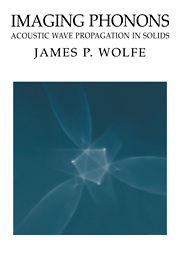Book contents
- Frontmatter
- Contents
- Preface
- Prologue – Anisotropic heat flow in crystals
- 1 Ballistic heat pulses and phonon imaging – A first look
- 2 Phonon focusing
- 3 Generation and detection of phonons – Experimental aspects
- 4 Focusing in cubic crystals
- 5 Acoustic symmetry and piezoelectricity
- 6 Lattice dynamics
- 7 Imaging of dispersive phonons
- 8 Phonon dynamics
- 9 Bulk scattering of phonons – Experiments
- 10 Quasidiffusion and the phonon source
- 11 Phonon scattering at interfaces
- 12 Refraction and reflection at solid/solid interfaces – Experiment
- 13 Imaging ultrasound in solids
- 14 Imaging surface acoustic waves
- 15 Interactions of ballistic phonons with electrons
- Appendix I Algebraic solution to the wave equation
- Appendix II Abbreviated tensor notation and group velocity
- Appendix III Survey of phonon focusing in cubic crystals
- Index
6 - Lattice dynamics
Published online by Cambridge University Press: 24 March 2010
- Frontmatter
- Contents
- Preface
- Prologue – Anisotropic heat flow in crystals
- 1 Ballistic heat pulses and phonon imaging – A first look
- 2 Phonon focusing
- 3 Generation and detection of phonons – Experimental aspects
- 4 Focusing in cubic crystals
- 5 Acoustic symmetry and piezoelectricity
- 6 Lattice dynamics
- 7 Imaging of dispersive phonons
- 8 Phonon dynamics
- 9 Bulk scattering of phonons – Experiments
- 10 Quasidiffusion and the phonon source
- 11 Phonon scattering at interfaces
- 12 Refraction and reflection at solid/solid interfaces – Experiment
- 13 Imaging ultrasound in solids
- 14 Imaging surface acoustic waves
- 15 Interactions of ballistic phonons with electrons
- Appendix I Algebraic solution to the wave equation
- Appendix II Abbreviated tensor notation and group velocity
- Appendix III Survey of phonon focusing in cubic crystals
- Index
Summary
In the previous chapters we saw how continuum elasticity theory leads to a rich variety of phonon focusing patterns. The predicted phonon images are completely determined by the elastic constants, in some cases modified by piezoelectric stiffening. An alternative approach is to model the microscopic forces between atoms in the crystal lattice. Such lattice dynamics models are necessary to explain the propagation of phonons with wavelengths comparable to the lattice spacing. Of course, these microscopic models must also be compatible with the continuum theory in the limit of long wavelengths. The purpose of this chapter is threefold: (1) to introduce the mathematical underpinnings of lattice dynamics, (2) to examine the connection between continuum mechanics and the theories of lattice dynamics, and (3) to summarize the predictions of selected lattice dynamics models for phonon wavelengths approaching the atomic spacings.
A basic question that arises is how the intricate anisotropies in elastic-wave propagation relate to the crystal structure and the forces between atoms. In particular, what arrangements of atoms and types of interatomic forces lead to elastic stability? … to positive or negative anisotropy factor, Δ? … to an elastically isotropic medium? Can one construct a hypothetical lattice that has the same sound velocity in all directions? What kinds of slowness surfaces do the simple force models predict? How sophisticated must the microscopic models be in order to predict the measured elastic properties of real crystals?
- Type
- Chapter
- Information
- Imaging PhononsAcoustic Wave Propagation in Solids, pp. 146 - 165Publisher: Cambridge University PressPrint publication year: 1998

